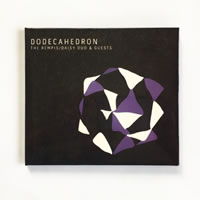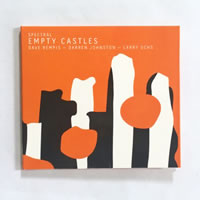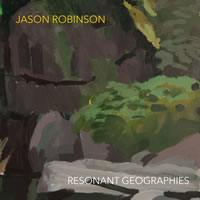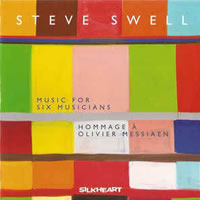Moment's Notice
Reviews of Recent Recordings
(continued)
The Rempis/Daisy Duo & Guests
Dodecahedron
Aerophonic 17
Spectral
Empty Castles
Aerophonic 16

 If by necessity improvisers need to be DIY artists, Dave Rempis is carving out a model mid-career. He’s a saxophonist by trade, a composer, and a band leader. But he’s also a curator, presenter, and record producer. Rempis is at the center of things in Chicago. He spearheaded, among other events, a weekly series at the Elastic Arts Foundation (where he is now president of the board). Currently, he’s operations manager for the Hyde Park Jazz Festival. Since 2013, his label, Aerophonic, has documented many of his special projects and ongoing collaborative ventures, from the Chicago Reed Quartet (with Ken Vandermark, Mars Williams, and Nick Mazzarella) to a trio with Joshua Abrams and Avreeayl Ra. Aerophonic is an absorbing and important venture, especially for those of us a long way from Illinois.
If by necessity improvisers need to be DIY artists, Dave Rempis is carving out a model mid-career. He’s a saxophonist by trade, a composer, and a band leader. But he’s also a curator, presenter, and record producer. Rempis is at the center of things in Chicago. He spearheaded, among other events, a weekly series at the Elastic Arts Foundation (where he is now president of the board). Currently, he’s operations manager for the Hyde Park Jazz Festival. Since 2013, his label, Aerophonic, has documented many of his special projects and ongoing collaborative ventures, from the Chicago Reed Quartet (with Ken Vandermark, Mars Williams, and Nick Mazzarella) to a trio with Joshua Abrams and Avreeayl Ra. Aerophonic is an absorbing and important venture, especially for those of us a long way from Illinois.
These two new albums, each an instance of pure improvisation, capture a seven-year-old cooperative, Spectral, with Bay Area-area musicians Larry Ochs (saxophones) and Darren Johnston (trumpet); and a twenty-year-old duo with drummer Tim Daisy. To mark this milestone, Daisy and Rempis added guests.
Improvisers have long sought out specific physical spaces to spur performance; just the right setting might help sculpt the interplay or shape the music’s shades and colors and ideas. Paul Bley, Evan Parker, and Barre Phillips’s 1996 recording Sankt Gerold (ECM), recorded at a monastery of the same name in the Austrian mountains, immediately comes to mind. Or Wayne Horvitz’s 55: Music and Dance in Concrete, a more recent multi-disciplinary work created for a former military site in Port Townsend, Washington.
Empty Castles, Spectral’s third recording, is an especially intense instance of this site-specific genre. Rempis, Ochs, and Johnston dropped down into Bunker A–168, a 12,000-square-foot former Second World War munitions bunker at the upper end of the San Francisco Bay in Vallejo, California. This long abandoned relic here becomes an irreplaceable part of the event.
It may not be surprising then to suggest there’s a haunting, keening quality to much of the performance. Empty Castles is an often grave, challenging 52-minute abstraction. The discrete instrumental arrangement – Rempis plays baritone and alto saxophones; Ochs plays tenor and sopranino – makes pathways easy to follow; there’s real clarity to the configuration, sharpened, as it is, by the use of extended techniques.
Instead of being just a conceit or, worse, a gimmick, the actual space becomes an additional voice. “Splash Zone,” for instance, goes in deep: this vaulting chamber effect, trumpet and baritone saxophone bounce and splutter and tuck, tenor all air and effects then a boring down. A crater, digging. Each voice (venue included) ultimately shapes the aural landscape. Even though the penultimate piece is titled “Bunker,” the disc might have been called that, too. Or, as Rempis, Ochs, and Johnston have referred to their way of working, “Invisible Architecture.”
On Dodecahedron, it’s Rempis and Daisy, partners since they first appeared on the Chicago scene in the late 1990s. On this two-disc set they’re captured alone together (Disc 1) and in six new trios (Disc 2) as they add, in turn, Steve Swell (trombone), Fred Lonberg-Holm (cello), Aaron Zarzutzki (electronics), Jim Baker (piano, electronics), Katie Young (bassoon, electronics), and Jason Adasiewicz (vibes). All of the music was recorded in the second half of 2017 at Elastic Arts.
It takes real courage to put out a record like this – more than two hours of music, and a first disc that includes just three improvisations (and a nearly half-hour opener). These are gutsy, barreling duos and they travel great distances, from shearing, sheet-metal discord to delicate, yearning meditations. The highlights to me are Rempis’s great serpentine runs, the stop-your-heart grooves. Midway through “EIKOSI” he and Daisy step into this wicked dance, a chase, a rollicking, darting spell that eventually drops down to a whisper of effects and space.
In trio, the colors are (by design I suspect) drastically different from one to the next. Adasiewicz is at one end of the spectrum – gracious, softening and supporting Rempis, who’s in an eerie mode (“ADR”). Lonberg-Holm might be at the other end – in his second piece, he turns the cello into fuzz guitar (“DLHR II”). To my ears, the Zarzutzki (“DRZ”) and Young (“DRY”) collaborations are especially rich.
On “DRZ,” the electronic possibilities feel infinite. Maybe it’s the saxophone’s natural properties, but Rempis is seemingly out front. Zarzutzki – ears wide open – welds, fuses, and stitches, making each electronic choice tell. This is a series of extraordinary trio gestures, a multi-part instant composition, in which the air between instruments becomes part of the cumulative effect.
On “DRY,” Young’s wonderful (and wild) bassoon-electronics combination forces you to rethink the basic relationship between voices. The improvisation begins in a weird, sustained soundscape. Soon, Daisy creeps in, a bobbling motion, pushing things forward. Electronic effects, echo, saxophone, then bassoon fill the space. Underneath, an arrow might just point us back to the bunker in Vallejo. An elusive, all-encompassing presence – rolling toms, reverb, long tones – stays with you long after the music is gone.
–Greg Buium
Jason Robinson
Resonant Geographies
pfMENTUM PFMCD115
 Resonant Geographies is Jason Robinson’s eighth recording as a leader, and the third featuring his Janus Ensemble. A meditation on place and memory, the album-length suite draws inspiration from locations relevant to Robinson’s biography, transposing personal reminiscences into dreamlike sound worlds. Each movement evokes a range of moods and sounds related to his recollections, interpreted by improvisers well versed in the work of iconic jazz composers whose influence can be heard in Robinson’s writing. For Robinson, who has worked in various settings (from electronically-augmented solo excursions to sideman gigs in roots reggae ensembles), this is his most ambitious project to date.
Resonant Geographies is Jason Robinson’s eighth recording as a leader, and the third featuring his Janus Ensemble. A meditation on place and memory, the album-length suite draws inspiration from locations relevant to Robinson’s biography, transposing personal reminiscences into dreamlike sound worlds. Each movement evokes a range of moods and sounds related to his recollections, interpreted by improvisers well versed in the work of iconic jazz composers whose influence can be heard in Robinson’s writing. For Robinson, who has worked in various settings (from electronically-augmented solo excursions to sideman gigs in roots reggae ensembles), this is his most ambitious project to date.
Issued by pfMENTUM, Resonant Geographies expands upon Robinson’s prior Cuneiform releases: Tiresian Symmetry, from 2012; and The Two Faces of Janus, the group’s 2010 quintet debut. Featuring some of today’s most esteemed improvisers, the expanded 11-piece version of Robinson’s Janus Ensemble is anchored by drummers George Schuller and Ches Smith, with bassist Drew Gress holding down the bottom end, aided by tuba player Marcus Rojas, multi-instrumentalist Bill Lowe (tuba and bass trombone), and trombonist Michael Dessen. Guitarist Liberty Ellman bridges the bass-heavy rhythm section and the multi-reed frontline of Marty Ehrlich, Oscar Noriega, J.D. Parran, and Robinson, who employ an assortment of woodwinds, from flute to contra alto clarinet.
Kaleidoscopic arrangements infuse the proceedings with a multihued palette reminiscent of the creative music orchestras of Muhal Richard Abrams and Anthony Braxton. The hocketed brass and syncopated rhythms of “Facing West” recall the intricate writing of Henry Threadgill, whose Very Very Circus ensemble Robinson has cited as an influence. A probing tuba solo by Rojas (a Threadgill alumni) reinforces the connection. Delving even further into the jazz continuum, the accelerating tempos and ardent horns of “Dreaming” suggest Mingus’ The Black Saint and the Sinner Lady, while the Ellingtonian sophistication of “Futures Unimagined” alludes to “Mood Indigo,” complete with Lowe’s growling, harmon-muted bass trombone.
Robinson seamlessly integrates tenets from the past into a modernistic synthesis; darting lines and dense harmonic passages exude an optimistic quality, with exuberant grooves and metric shifts generating forward momentum. Other than a few muscular tenor solos, Robinson generally eschews the spotlight, assuming the magnanimous role of bandleader; the suite covers a wide variety of stylistic territory, featuring each musician in collaborative and solo settings. Some sections explore abstract tonalities, while others swing majestically, recalling the vim and vigor of the early big bands.
What unifies the work is Robinson’s seamless integration of different sound worlds into a singular aesthetic that encompasses historical references, individual expressions, and collective improvisation. Executed by a multi-generational line-up representing an intriguing cross-section of contemporary music scenes, Resonant Geographies demonstrates an all-inclusive world view, proving that a vast array of new creative possibilities is available to forward-thinking artists familiar with past innovations.
–Troy Collins
Matthew Shipp Quartet featuring Mat Walerian
Sonic Fiction
ESP Disk’ ESP 5018
 Celebrated pianist Matthew Shipp, and rising Polish multi-instrumentalist Mat Walerian, have collaborated frequently over the last few years, with three previous albums for ESP Disk’ to their credit. The pair released Live at Okuden as the Uppercut in 2015, followed by two Walerian-led trio dates – one featuring drummer Hamid Drake, the other bassist William Parker. Sonic Fiction finds Shipp and Walerian in a quartet setting, aided by the veteran duo of bassist Michael Bisio and drummer Whit Dickey. Bisio has been a member of Shipp’s trio since 2009; Dickey has a long history with Shipp, appearing on over a dozen of the pianist’s albums.
Celebrated pianist Matthew Shipp, and rising Polish multi-instrumentalist Mat Walerian, have collaborated frequently over the last few years, with three previous albums for ESP Disk’ to their credit. The pair released Live at Okuden as the Uppercut in 2015, followed by two Walerian-led trio dates – one featuring drummer Hamid Drake, the other bassist William Parker. Sonic Fiction finds Shipp and Walerian in a quartet setting, aided by the veteran duo of bassist Michael Bisio and drummer Whit Dickey. Bisio has been a member of Shipp’s trio since 2009; Dickey has a long history with Shipp, appearing on over a dozen of the pianist’s albums.
The expanded lineup affords Walerian and Shipp their first opportunity to interact with a full rhythm section in a studio environment. Though capable of ecstatic reveries, Walerian often plays with smoldering restraint; his frequently meditative approach brings out Shipp’s introspective side, which in turn alters Bisio and Dickey’s roiling dynamics. Focusing on space and sound, these ten original compositions (all written by Shipp) explore a wide range of moods. Except for the lengthy title track, most of the numbers range from four to six minutes, covering an array of stylistic territory and varied personnel combinations. This democratic approach has become Shipp’s modus operandi, enabling each musician to express themselves at length, in a variety of settings.
The contemplative “First Step” introduces the program; Shipp’s plaintive voicings, Walerian’s breathy alto, Dickey’s shimmering cymbals, and Bisio’s haunting arco lend a bluesy, noir-inflected atmosphere to the proceedings. The drum-less “Blues Addiction” follows, with a harmonious piano solo that gives way to a languid duet between contrabass and clarinet. Unaccompanied pieces showcase individual performers: “The Station” is a ruminative meditation for Walerian’s probing bass clarinet, while the fugue-like “Easy Flow” is a gently eccentric piano soliloquy. Other tunes, like “Lines of Energy” and “3 by 4” are raucous swingers. Even further afield, “The Problem of Jazz” eschews piano entirely to emphasize a propulsive groove by Bisio, whose breakneck runs are periodically interrupted by fervent eruptions of alto and drums, before winding down to a slow blues coda. Closing the date, the epic title track demonstrates how Walerian has adapted to Shipp’s artistry. Improvising in tandem, their distinctive voices find harmony in an episodic opus that veers far and wide, rallying to a futuristic re-imagining of bop.
Expertly sequenced, these pieces flow like a suite; themes and motifs reappear in altered form throughout the date. In keeping with the unit’s democratic design, each musician’s role is essential. Shipp’s magnanimous approach to leadership often places Walerian and Bisio out front as Dickey alternates propulsive timekeeping with understated shading and texture. The music evokes Walerian and Shipp’s prior efforts; the multi-reedist’s playing is subtly inventive, yet never leaves the blues behind, making an effective contrast to the leader’s neoclassical technique. Bolstered by the idiosyncratic contributions of Walerian, Sonic Fiction marks a new phase for Shipp, evolving from the duo’s previous outings towards a new, shared aesthetic.
–Troy Collins
Matthew Shipp
Symbol Systems
hatOLOGY 749
 Having been knocked out by last year’s solo Shipp, Invisible Touch, it’s been mighty intriguing for me to reinvestigate Shipp’s first solo album, from 1995. Originally on No More Records, hatOLOGY has given Symbol Systems a brilliant remastering and presentation.
Having been knocked out by last year’s solo Shipp, Invisible Touch, it’s been mighty intriguing for me to reinvestigate Shipp’s first solo album, from 1995. Originally on No More Records, hatOLOGY has given Symbol Systems a brilliant remastering and presentation.
By 1995, Shipp’s language was already distinctive and well-wrought. The pieces range in feel and duration, and at times Shipp allows one of his many influences or stylistic components to move to the fore. For example, on the opening “Clocks” I get a lovely impression of Satie. I’ve often been a fan of such ruminative moments in Shipp’s oeuvre, and there’s plenty to enjoy here – such as the lovely billowing dark clouds and tasty inside piano stuff on the brief “Temperate Zone.” But the most effective pieces here are those that combine atmospheric playing with knotty, sometimes dissonant note-heavy work.
Shipp can shift on a dime, executing with great technical assurance the rapid cycle of ideas and inclinations he thinks up. But nothing about the process seems arbitrary. There’s a focus, almost a thematic emphasis to many pieces here, not the ramble you sometimes get in solo performance. Instead, the bright, jabbing “Harmonic Oscillator,” where Shipp is all over the keyboard, has a kind of narrative quality to it (ditto the densely harmonized title track). “The Highway” effectively balances somber reflections with some pinwheeling, almost Monk- or Bud-influenced passages. What’s more, this track (and the excellent “Bop Abyss”) features some gnarly, punishing swing in here too, like Tristano after he’d listened to a few metal records. And if you’re looking for sheer exuberance, proceed to “Flow of Meaning” and “Dance of the Blue Atoms,” the latter with some dazzling shifts in register and consistent right-hand trilling. It’s all dense, elegant, and brilliantly executed.
–Jason Bivins
Steve Swell
Music for Six Musicians: Hommage À Olivier Messiaen
Silkheart SHCD 161
 If for nothing else, Olivier Messiaen deserves homage for Quatuor pour la fin du temps. Its creation was nothing less than heroic; written while he was imprisoned by the Nazis, its unusual configuration of piano, clarinet, violin and cello dictated by what was available in the camp, it is one of the century’s truly compelling works of art, the peer of Picasso’s Guernica and few others. But, there are other reasons why Messiaen is relevant to jazz-steeped composers like Steve Swell. Messiaen was a legendary improviser during his six decades as the organist for the Church of the Sainte-Trinité in Paris. (For an illuminating discussion of improvising church organists in Paris, consult Derek Bailey’s Improvisation: its nature and practice in music.) Like countless jazz-oriented improvisers, Messiaen was also profoundly influenced by birdsongs, which he eventually traveled the world to notate and catalog, often incorporating them into his works. Additionally, the spiritual motivation of his music was as acute as that of Coltrane and Ayler.
If for nothing else, Olivier Messiaen deserves homage for Quatuor pour la fin du temps. Its creation was nothing less than heroic; written while he was imprisoned by the Nazis, its unusual configuration of piano, clarinet, violin and cello dictated by what was available in the camp, it is one of the century’s truly compelling works of art, the peer of Picasso’s Guernica and few others. But, there are other reasons why Messiaen is relevant to jazz-steeped composers like Steve Swell. Messiaen was a legendary improviser during his six decades as the organist for the Church of the Sainte-Trinité in Paris. (For an illuminating discussion of improvising church organists in Paris, consult Derek Bailey’s Improvisation: its nature and practice in music.) Like countless jazz-oriented improvisers, Messiaen was also profoundly influenced by birdsongs, which he eventually traveled the world to notate and catalog, often incorporating them into his works. Additionally, the spiritual motivation of his music was as acute as that of Coltrane and Ayler.
Swell’s Music for Six Musicians: Hommage À Olivier Messiaen impressively demonstrates his affinity for the composer on several counts. His choice of instrumentation is salient: violinist Jason Kao Hwang (who doubles on viola) and cellist Tomas Ulrich mirrors Messiaen’s string palette on Quatuor; and the inclusion of Robert Boston, who is equally persuasive on piano and church organ, allows Swell an abundance of palette options. Yet, Swell is not simply rehashing Messiaen’s legacy with these choices; complemented by Jim Pugliese, a percussionist who can amplify the orchestral heft of a small group as well as supply jazz-informed heat, and alto saxophonist Rob Brown, a prime beneficiary of Jimmy Lyons’ trailblazing, this is a dynamic ensemble.
Approaching Messiaen poses manifold challenges to Swell as a composer. Messiaen achieved uncanny fluidity in his orchestrations, even when his materials were trenchant, even severe. There is palpable rigor propelling Messiaen’s compositions that demands exact execution. And, there is an emotional intensity that defies easy descriptors like “ecstatic.” Swell has to meet these standards, a task complicated by the significant role improvisers play in his album-length tribute, and the need to match them with the variously toned open spaces in his compositions. Throughout the album, Swell intermediates Messiaen’s penchant for monumental scale (the 24-minute “Opening”), moral messaging (“Sextet for the End of Democracy”), and love of polyphony (“Vautour Fauve”) with his 21st Century American lexicon.
Swell’s colleagues deliver time and again to fully realize this ambitious project. Brown and Hwang exceed the high expectations that come with being among the more familiar voices on their respective instruments. The cogency of Pugliese and Ulrich begs the question of why they are infrequently heard on disc. Boston, for whom writing and performing for dance companies is a major focus of his work, is a welcomed discovery. And, Swell confirms his stature as a preeminent trombonist. In adding vivid contrasting threads to an already complex tapestry, each member of Swell’s sextet contributes to the impact of Music for Six Musicians: Hommage À Olivier Messiaen, one of the more important recordings of the past few years.
—Bill Shoemaker